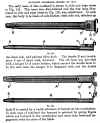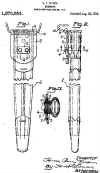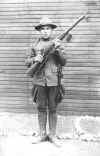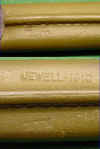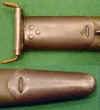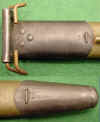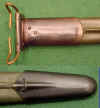Updated Sept. 1, 2003
Bayonet Points #11
The Bayonet Scabbard, Model of 1917
In Bayonet Points #10, I discussed some of the variations of the Model 1917 Bayonet that might be of some interest to the collector. There are not as many variations of the scabbard (that I am aware of), but I have had enough questions about them that I feel now may be a good time to show a few scabbards that the collector might look for. In Bayonet Points #7, I mentioned the World War 2 and later plastic scabbards, so those that might be interested in the later scabbards are invited to read that section.
The Description and Rules for the Management of The United States Rifle, Caliber .30, Model of 1917 shows the two basic scabbard styles used in World War One.
The Model 1917 Scabbard As Shown In The
May 7, 1918 Revision Of The M1917 Rifle Manual
The earlier style scabbard was a design patented by Hiram Percy Maxim, quite well known of course in the firearms field for the famous Maxim Silencer. The Patent (#1276554) was not granted until August 20, 1918, although it had been filed June 20, 1917. The Patent was assigned to the Maxim Silencer Company of Hartford, Connecticut. The Patent (illustrated below) dealt with the method of hanging the scabbard from the cartridge belt or other attachment point as the rest of the scabbard was standard British design and issue.
The Maxim Patent Drawing of the 1st Pattern Model 1917 Scabbard
The 1st and 2nd style scabbards were manufactured by two makers, Graton and Knight of Worcester, Mass. (closed in 1962) and the Jewell Belting Company of Hartford, Conn. Both of these companies were manufacturers of the large leather belts that were used to transmit power from a shaft to various machines within a manufacturing facility. According to Benedict Crowell in America's Munitions, Rock Island Arsenal manufactured 3,000 of these scabbards. I have never seen an R.I.A. marked Model 1917 scabbard, but with that very low number, that is not surprising. Crowell also states that G&K delivered 1,669,581 and Jewell 1,810,675.
The 1st Pattern Model 1917 Scabbard
Markings On The Hangers Of The 1st Type M1917 Scabbards.
The 1st Pattern scabbards were marked on the hanger assembly, G&K over 1917 for Graton and Knight, and JEWELL over 1917 for Jewell Belting. In this photo, note the difference in the stitching patterns at the top just under the double hooks. The G&K is stitched completely across under the double hook and the Jewell is not. I have a G&K with the same pattern as on the Jewell, but in my limited viewing to date have not seen a Jewell stitched completely across. Just as a guess, the G&K pattern shown would be stronger and was probably later, but I am not sure. Does anyone have a Jewell with the all across stitching pattern?
I have no information on how many were made before the change was made to the 2nd Pattern, or when the change was actually made. The attachment of the hanger to the scabbard is a weak point, and it probably became quickly evident that the method of attachment needed to be improved. I have never seen a 1918 dated one, and I believe the change was made in late 1917. They are fairly uncommon today, but since they were made early in the war, and were not very strong, it is likely that even if fairly large numbers were made they would not have survived well.
A 1st Pattern Model 1917 Scabbard In Use Circa 1917.
A few collectors have contacted me and stated that they had examples of the first type scabbard but rather than being painted the normal olive drab color, they are a brown to black color similar to the British Pattern 1907 scabbard. I have one of these myself, which although in well used condition, does not appear to have been painted. The body is more or less a rough side out black leather, and the leather hangar is a fairly smooth brown. It is of course possible that some Pattern 1907 leather scabbards made up for the British contract were used in the first production of these scabbards for the US, just as some of the British marked bayonets were utilized. However, I have absolutely no documentation from official sources that such bodies were used.
Whenever it may have occurred, a change was made to form an extension on the mouthpiece that carried the double hook. This resulted in a much stronger system, and the same basic pattern was used on the M3, M7, and later M1917 scabbards.
The 2nd Pattern Model 1917 Scabbard
The second pattern scabbard was also made by G&K and Jewell, but the markings were moved to the back of the body. G&K marked theirs horizontally (with the scabbard vertical) and changed the mark to GK while Jewell continued to spell out their name. Those made by Jewell are found dated 1918, those by G&K are undated. I have not noted a 1917 date on the Jewell marked scabbards - does anyone have one so dated? Various inspectors' initials will normally be found on the back also.
Markings On The 2nd Pattern Model 1917 Scabbard
The upper and lower metal portions (throat at the top, ferrule at the bottom) are found marked either M.S., GF in an oval, or unmarked. I presume these are the initials of the company that made these parts, but have not been able to locate any information about who these contractors may have been, or why some are found unmarked. The M.S. mark is also found on the 1917-1918 trench knife scabbards manufactured by Jewell. Frank Trzaska has suggested that the M.S. may be the mark of the Maxim Silencer Co. (mentioned earlier as the holder of the patent for the first type scabbard hanger) and this makes good sense to me as the company certainly had the capability to roll and form sheet steel in this manner.
GF Markings Found On The Model 1917 Scabbard
M.S. Markings Found On The Model 1917 Scabbard
At times, other marks added later can be found on these scabbards. Most common are painted on numbers, probably indicating a rack or issue number within a unit. I have seen a few like the one illustrated here, with a name stamped on with a rubber stamp. This type of marking is most commonly associated with Navy/Marine issue, although it does not have to be.
L. K. ROGERS Markings Found On A Model 1917 Scabbard
Like the Model 1917 rifles, the bayonets and scabbards were widely distributed during WW2 to other countries. As mentioned in the previous article on the bayonets (Bayonet Points #10), the bayonets can be found with Canadian and Danish markings. Rifles (and bayonets) were also supplied to England, China, and France during the WW2, and other nations post war Rebuilds and refinishes by these countries were common, and today a lot of the scabbards are found repainted in all shades of olive drab as well as black and other colors.
When the rifles and bayonets went to England, they used their canvas frogs to support the scabbard on their web gear. Sometimes they were used with the double hook remaining on the scabbard, while at other times the extension holding the double hook was ground off. Following WW2, Denmark was given a number of the Model 1917 Rifles by England, and the Danes used a double hook adapter for attaching equipment to their belts. They made a new top plate with double hooks, and brazed this to the top of the throat of the scabbards that were missing them. This results in a "double layer" on the top plate as shown in the photo below.
Danish Modification Of The Model 1917 Scabbard
For many years I have owned a scabbard that was said to be of foreign manufacture, but I feel that it may be a reproduction for the commercial market. The leather is thinner as is the metal of the throat and ferrule. The metal parts are lightly blued, The rivets are smaller, and the staples holding the throat and ferrule on are thinner. The wire double hooks are of a thinner wire, and bent at a wider angle making it hard to assemble to a US belt. It is totally unmarked. If anyone knows if this is a commercial reproduction or a foreign military issue, I would appreciate hearing about it.
Reproduction? Model 1917 Scabbard
I am sure I have not seen or have overlooked other variants of this scabbard. If you know of any, or have answers to any of the questions I posed, please let me know,
